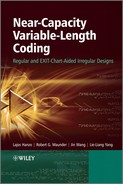Preface
Variable-Length Codes (VLCs) have as long a history as that of information theory. Shannon’s original lossless entropy codes adopted the conceptually appealing philosophy that a stream of binary source data may be partitioned into fixed-length data segments, where the segments having a low probability of occurrence may be assigned long codewords, while the high-probability ones must have short codewords assigned to them. This facilitates the reduction of the average number of bits that has to be transmitted. A further design criterion is that no shorter codeword may constitute a prefix, i.e. the initial segment of a longer codeword.
Naturally, the compressed data stream becomes more susceptible to the loss of synchronization in the presence of transmission errors, in the sense that the decoder cannot recognize a corrupted codeword and hence it is bound to read past the end of the original error-free codeword. This phenomenon potentially prevents the decoder from recognizing the next legitimate codeword, and hence can result in an avalanche-like error propagation. In order to circumvent this potential problem, numerous design alternatives have emerged. Examples include Variable-Length Error Correction (VLEC) codes and reversible VLCs (RVLCs) (which contain redundancy in the sense that they are constituted by a bit-pattern that is symmetric with respect to the middle, and hence may be decoded from both ends).
The family of VLCs has also found its way into virtually all video and audio compression standards, which are used by widespread consumer products, and yet there has been no dedicated book on the subject of VLCs. This volume aims to fill that gap, with the objective of reporting on the most recent research advances, including iterative turbo decoding and irregular designs based on EXtrinsic Information Transfer (EXIT) charts. The proposed code design principles are generic, and hence they may be applied to arbitrary code design problems.
Our intention with the book is:
- First, to pay tribute to all the researchers, colleagues and valued friends who have contributed to the field. Hence this monograph is dedicated to them, since without their quest for improved VLCs it could not have been conceived. They are too numerous to name here, but they appear in the author index. Our hope is that the conception of this monograph on the topic will provide an adequate portrayal of the community’s research and will further fuel this innovation process.
- Second, to stimulate further research by exposing open research problems, and by collating a range of practical problems as well as design issues for the practitioners. The coherent further efforts of the wireless research community are expected to lead to the solution of a range of outstanding problems, ultimately providing us with flexible joint source- and channel-coded wireless transceivers exhibiting a performance close to the information theoretical limits.
